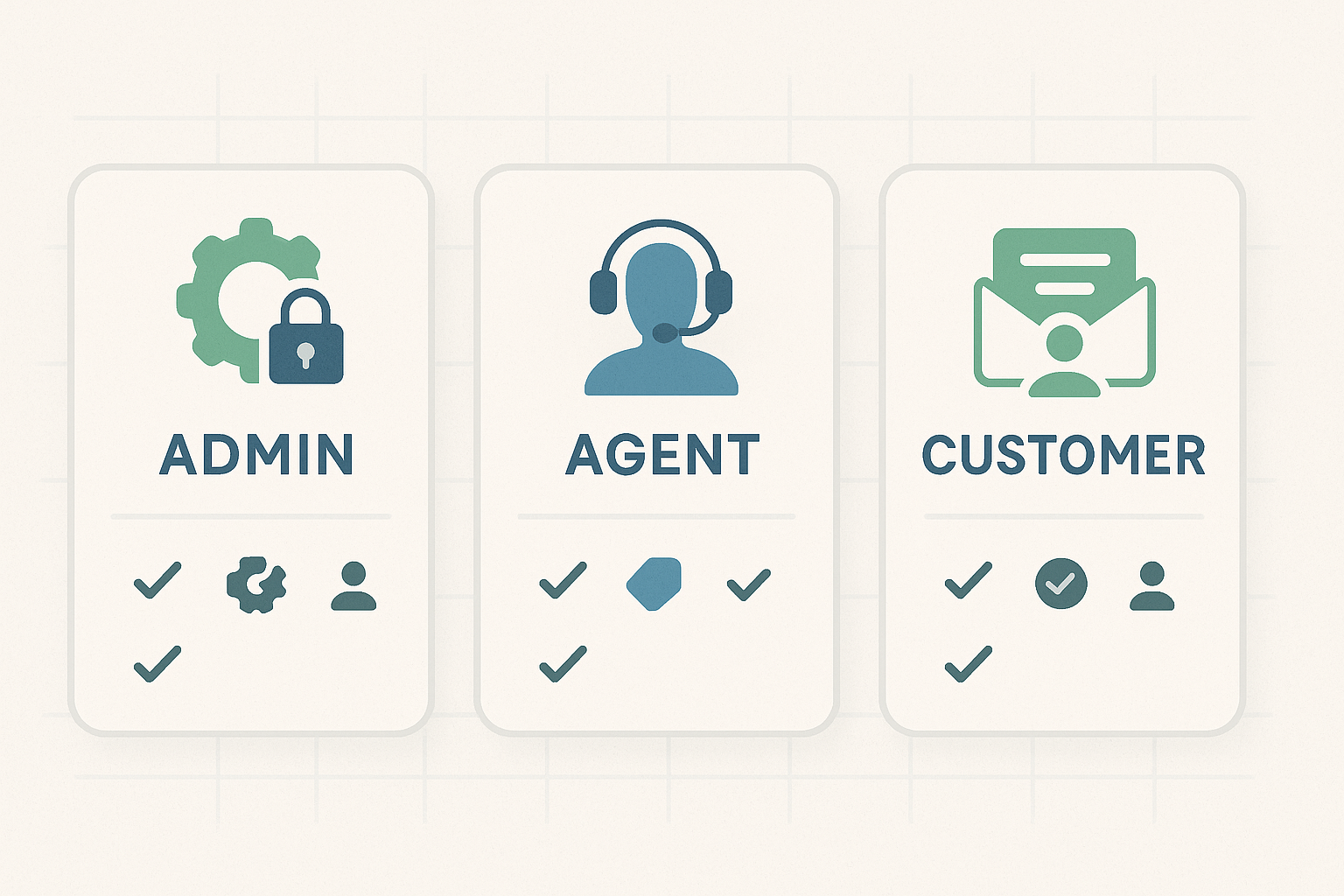The right helpdesk roles keep tickets moving while protecting customer data. With a lean role model, small teams stay fast, avoid risky access, and reduce admin work.
What are helpdesk roles?
Helpdesk roles define what each person can view and do. Clear roles reduce noise, improve focus, and create an audit path for important changes. Most importantly, they apply the principle of least privilege so each user gets only what they need to do the job. For background, see Microsoft’s guidance on the principle of least privilege in zero trust identity.
Signs your roles need a reset
- Agents can see tickets from other teams and get distracted
- Leads cannot reassign or run reports without admin help
- Admin access is too common and hard to track
The minimal role set for small teams
A compact set of helpdesk roles is easier to understand and maintain. Start with these four.
Agent
- Read and reply to assigned tickets
- Add internal notes, tags, and attachments
- Create views that show only their work
- No access to user management or global settings
Lead
- Everything the Agent can do, plus:
- Reassign and merge tickets
- Approve escalations and pause SLAs when needed
- Run reports and manage team views
Admin
- Create and deactivate users
- Edit workflows, automations, and tags
- Configure integrations and security settings
- Review audit logs and export data
Contributor
- View selected tickets and add internal notes only
- Ideal for engineering, product, or finance partners who do not need reply permissions
For a day one setup that pairs well with this role model, use our concise guide: How to set up a helpdesk for your small team in one day.
Helpdesk roles in practice: least privilege without friction
Least privilege should not slow anyone down. Instead, use it to focus attention and reduce mistakes.
- Start new hires as Agent by default
- Grant Lead to the team lead or on-call lead only
- Keep Admin limited to 1 or 2 people
- Use Contributor for cross-functional partners who need read access
If you need a reference model, Atlassian documents how to segment permissions in service tools. Their overview of Jira Service Management permissions shows how role scopes map cleanly to actions.
Onboarding flows that auto-assign roles and default views
Role assignment should be automatic. Otherwise, new hires wait for access and lose momentum. During onboarding:
- Automatically assign Agent and subscribe them to their team queue
- Preload macros, saved replies, and SLAs
- Provide a 15-minute walkthrough of queues and views
- Confirm the role as part of your helpdesk onboarding checklist
Role-based queues and data visibility
Queues should match helpdesk roles so agents see only relevant work.
- Agents see My Tickets, Team Inbox, and Mentions
- Leads see all team queues plus Escalations and Breaches
- Admins see every queue and the configuration area
- Contributors follow tickets they are asked to review
This structure keeps eyes on the right work, therefore response times improve.
Auditing role changes without enterprise complexity
You do not need heavy tooling to track permissions responsibly.
- Maintain a shared table with user, role, scope, and approver
- Record why the change happened and when it should be reviewed
- Export an audit log monthly and store it with your security docs
- Review quarterly in a 15-minute check with the admin and team lead
Common pitfalls and quick fixes
Too many roles.
Collapse overlapping roles into the four core types. Then document the differences in a one-page table.
Permanent elevated access.
Use time-boxed elevation for projects. Afterwards, revert to the baseline role.
No audit trail.
Adopt the simple change table above. In addition, screenshot settings after major updates.
Role creep over time.
Schedule a quarterly review. Remove unused views, macros, and tag permissions that no longer match responsibilities.
Implementation checklist
Use this short plan to roll out helpdesk roles in a week.
- Define Agent, Lead, Admin, and Contributor in your tool
- Map each permission to a role and remove extras
- Set the default role for new users to Agent
- Create role-based views and queues
- Limit Admin to the minimum and add a break-glass account
- Build the role change table and store it with security docs
- Train leads on reassignment, escalation, and reporting
- Compare your structure with a shared inbox and decide why roles win: Shared inbox vs helpdesk
A simple, people-first view of roles that keeps work moving.
Conclusion
With a lean set of helpdesk roles, small teams stay focused, secure, and fast. Apply least privilege, automate onboarding, and review changes regularly so permissioning never blocks the work.
Start your free 14 day trial to set up roles, automate workflows, and keep support running smoothly.
